Understanding how to manage TikTok Shop orders can feel overwhelming, especially for new sellers who are navigating a maze of policies regarding orders, cancellations, returns, and refunds. The platform’s guidelines are detailed; missing a step can lead to delays or customer dissatisfaction.
In the fast pace of running an online shop, it’s easy to miss key rules or leave issues unresolved. Over time, these slip-ups can hurt your reputation and trigger negative reviews.
The good news? Managing your TikTok Shop doesn’t have to be stressful. This guide simplifies the process, helping you master the essentials and confidently handle every order from start to finish.
How to fulfill TikTok Shop orders
When a customer places an order, TikTok sends a notification directly to your app. You have five days to ship the item from that moment. If the order is not fulfilled within this timeframe, TikTok will automatically cancel it.
If you’re feeling overwhelmed and unable to process all your orders, there’s some flexibility. TikTok often extends the shipping window during peak periods such as winter sales or Black Friday. It’s essential to keep your customers informed if there are any expected delays.
To manage and track your orders, visit the order management section in your seller dashboard. At the top of the page, the “Action Needed” box highlights any orders requiring immediate attention.
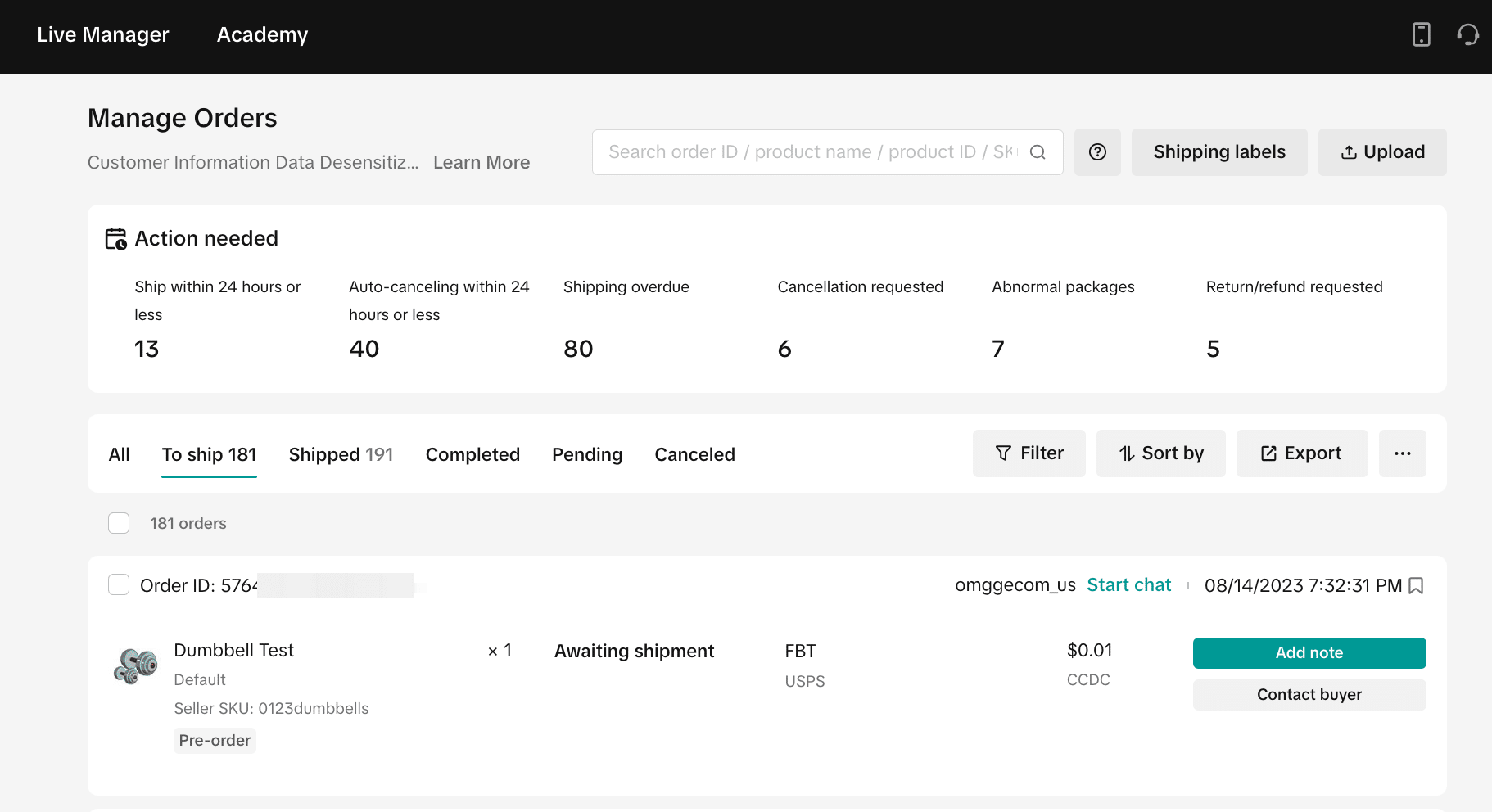
You get to choose who delivers TikTok orders from the following options:
- Seller Shipping: Arrange your shipment and delivery (provided TikTok supports your logistics partner)
- TikTok Shipping: Choose a provider from the list in the TikTok Shop’s Seller Center
- Fulfilled by TikTok: Outsource the entire shipment process from storage and collection to delivery to the TikTok team
Each option comes with pros and cons. For example, Seller Shipping gives you greater control but means you can’t benefit from TikTok’s discounts and deals.
TikTok lets you ship products globally, but its support is limited compared to some alternatives. To expand your reach, it’s best to combine your social media channels with a dedicated ecommerce site. This way, you can access more local shipping options and foreign markets without having to give up your TikTok.
How to handle canceled orders
Initial Cancellation Window
Customers have a one-hour pending period after placing an order. If they choose to cancel during this time, the order is voided and treated as if it had never been placed.
After the pending period ends, customers can still submit a cancellation request. When this happens, TikTok will notify you through your seller dashboard, including the reason for the cancellation.

Responding to Cancellation Requests
Sellers have 24 hours to accept or reject the cancellation by uploading valid tracking information. If you do not take action within that time, TikTok will automatically cancel the order. To avoid missing these requests, it’s a good practice to check your shop dashboard daily.
Delayed updates or shipping may also prompt customers to cancel their orders later. If you expect delays, use the in-app messenger to keep customers informed. Frequent cancellations not only reduce your sales but may also impact your shop’s visibility on TikTok.
How to cancel orders on TikTok Shop as the seller
When and How to Cancel an Order
There may be situations where you need to cancel an order yourself, such as when items are damaged or there are shipping issues. In these cases, the cancellation process differs from the one customers follow.
To cancel an order as a seller, follow these steps:
-
Open your order management dashboard.
-
Locate the order you wish to cancel.
-
Click the drop-down menu on the right-hand side of the order box.
-
Select Cancel.
-
Choose a reason for the cancellation.
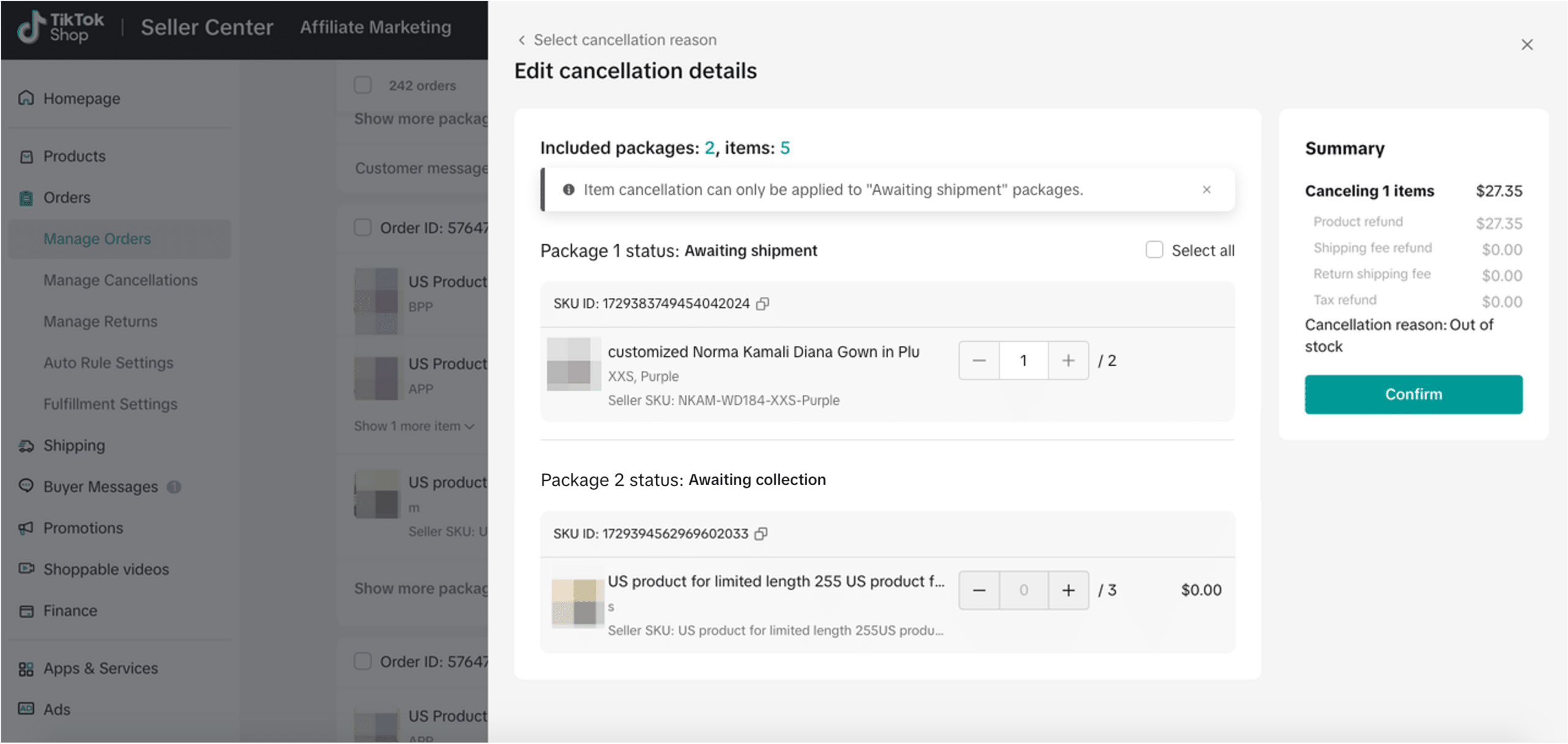
Important Restrictions and Considerations
Once the order status updates to To Ship, Awaiting Collection, cancellation is no longer possible. The parcel is already in transit at that stage, and TikTok cannot reverse the process.
Before canceling an order, consider contacting the customer. You may be able to resolve the issue or offer an alternative. For example, if shipping to the listed address is impossible, the customer might update it to a supported location.
Do not ask the customer to cancel the order on your behalf. While this might seem like a way to reduce your cancellation rate, it violates TikTok’s seller policies.
Canceling a Single Item from a Larger Order
If a customer places a large order and discovers one or more items are unavailable, you do not have to cancel the entire order. TikTok allows you to cancel individual items.
In such cases, follow the standard cancellation steps but apply them only to the affected items. Contact the customer, explain the situation clearly, and offer a suitable solution.
How to handle returns and refunds
Around one in ten products bought online get sent back. That means even if you only sell a few items monthly, you must get to grips with refunds and returns.
Customers have 30 days from the date the order status changes to ‘Delivered’ to request a refund. After that, they may only raise a claim for damaged or defective goods.
When you get a refund request, what you do next depends on the product type.
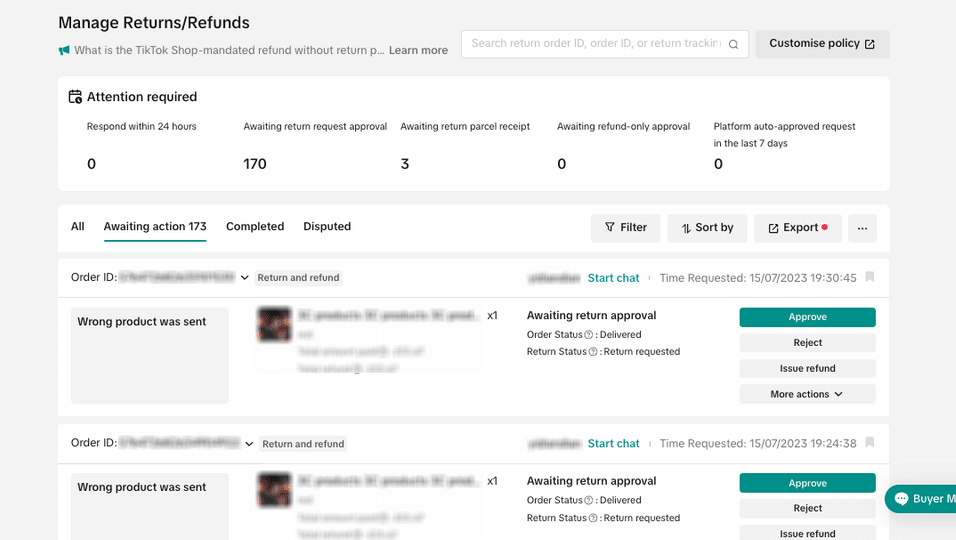
Returnable products
The platform automatically accepts a refund request if a customer requests one within TikTok’s 30-day return window. As the seller, your responsibility is to wait for the product to be returned. Once you receive the item, inspect its condition and decide whether to approve the refund.
Act quickly, as you have only two to four days to dispute the refund if needed. If you do not respond within this time, TikTok will automatically process the refund to the customer.
If the return is due to an issue, such as a damaged or incorrect item, you will be responsible for covering the return shipping costs. Otherwise, TikTok or the customer will handle the shipping charges.
One helpful policy is that some TikTok users are eligible for “refund without return” on items priced under $10. In these cases, the customer receives a refund without returning the item, and you are still fully reimbursed. No additional action is needed on your part.
Non-returnable products
Certain products are not eligible for return due to hygiene or safety concerns. These typically include perishable goods such as food, beverages, or items that spoil quickly.
Sometimes, TikTok may request that customers return high-value non-returnable items so you can inspect them and verify the refund claim.
As with returnable products, you have two to four days to review the item and decide whether to approve or dispute the refund. If you do not act within that period, TikTok will automatically refund the customer.
How to handle sales tax
If you’re unsure which tax rates to apply, there’s good news: TikTok handles the collection and remittance of sales tax for all customer orders in regions where it is required. This means you don’t need to calculate or submit taxes manually, which simplifies the process for sellers.
However, one potential drawback is that TikTok collects and remits sales tax even for customers who may be eligible for tax-exempt purchases. As a result, you could lose sales to businesses using platforms that allow for tax-free transactions.
As your business grows, you might consider selling on additional ecommerce platforms. Solutions like Shopify and WooCommerce give you full control over how sales tax is handled, allowing for more flexibility in managing orders and pricing. Many platforms also support direct integration with TikTok Shop, so you can synchronize your orders, sales, and inventory. For instance, if you already operate a Shopify store, you can connect it to your TikTok Shop.
What to know about TikTok Shop fees
While TikTok Shop is free to join, the platform does deduct a percentage from each completed order. These fees vary depending on your location and the product category, but here are the main types to be aware of:
-
Market Commission: A percentage of each sale that covers TikTok’s platform and marketplace services.
-
Transaction Fee: A fee charged for processing payments made through the platform.
-
Shipping Fee: This is the cost of delivery, which you may need to cover if you offer free shipping or are responsible for return shipping.
-
Affiliate Payments: Commissions paid to creators or influencers who promote your products through TikTok’s affiliate program.
Understanding these fees can help you price your products more effectively and manage your profit margins.
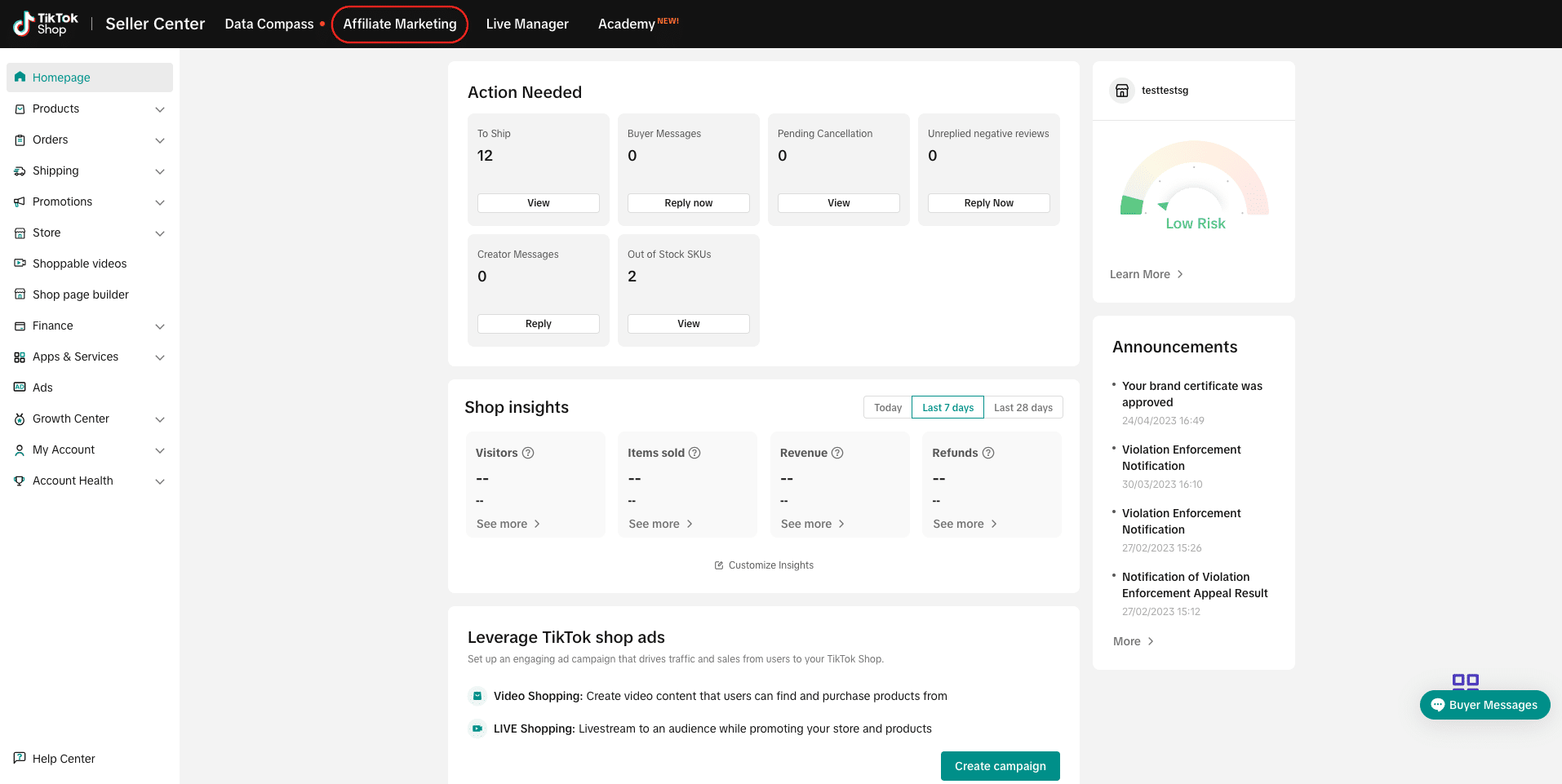
Most TikTok Shop fees are deducted automatically, so you don’t need to transfer funds manually. However, shipping costs can vary depending on the method you select. In some cases, you may need to pay third-party logistics providers directly.
For new sellers, TikTok’s fee structure is often manageable, especially if you’re only processing a small number of orders. As your business grows, though, these variable fees can start to reduce your profit margins.
If your side hustle begins to turn into a full-time business, it may be worth exploring ecommerce platforms that charge a fixed monthly rate. These solutions can offer better cost predictability and more control over your operations.
Tips for making sure TikTok orders get to customers
Understanding and following TikTok’s rules is only half the story. You need to follow some best practices to ensure customers get the products and don’t return them.
Here’s what to bear in mind:
- Make clear product listings: Make sure your description is accurate and detailed, and images reflect what the items look like. This reduces the likelihood of customers getting disappointed and wanting to request returns.
- Track inventory: Actively monitor TikTok products and restock so there’s less danger of you running out of products without realizing.
- Move quickly: Fulfil orders as soon as possible so customers have less time to overthink their purchase and change their minds.
- Keep customers updated: Tell customers if you’re experiencing difficulties so they know what to expect. They’ll be more satisfied with your service and less inclined to cancel if they see the delivery’s a little late.
- Take grievances to TikTok: When you suspect the customer has damaged the product, report the issue to TikTok. Be prepared to accept their verdict, though.
- Pick your battles: Even if you’re in the right, sometimes it might be worth offering a refund and accepting the return for minor issues.
- Integrate with the right tools: As you’re running a business, you probably need to report your income and expenses to local tax authorities. Use dedicated accounting solutions like QuickBooks and Xero to record your financial activities and balance your books.
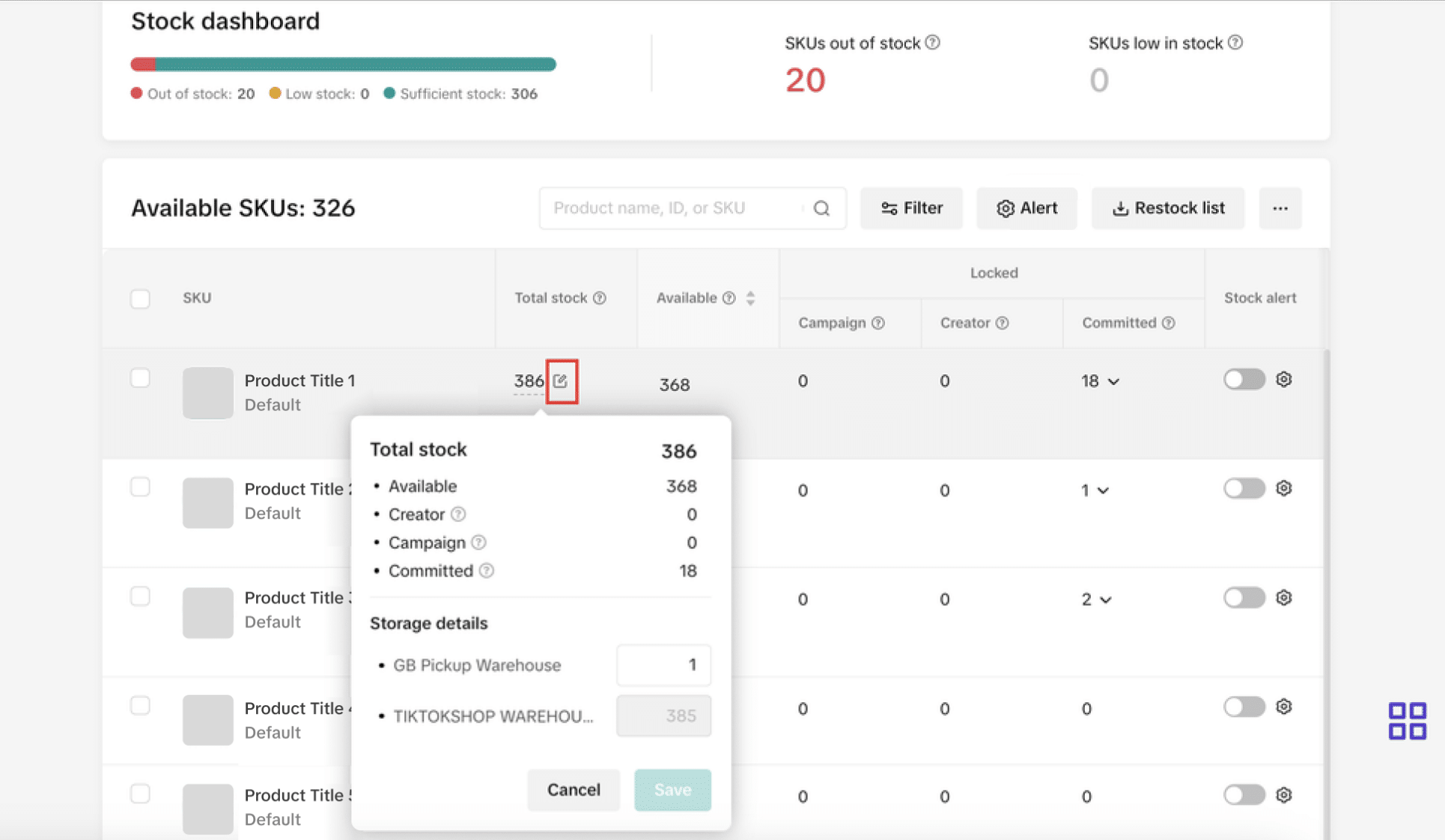
Ready to get more control over the order process?
TikTok Shop’s built-in rules can be helpful for new sellers. They provide a structured framework, so you don’t need to create or enforce your policies from scratch.
However, as your business grows, you may need greater control over the order process. At that stage, it may be time to shift your core operations to a dedicated ecommerce platform like Shopify or WooCommerce.
These platforms offer more flexibility in managing orders, refunds, and returns. You can set your policies, tailor the customer experience, and optimize fulfillment workflows. Still, there’s no need to leave TikTok entirely. You can continue promoting and accepting orders on TikTok while managing inventory and order fulfillment through your leading ecommerce site.
| Record order data no matter where it comes from
MyWorks connects your Shopify or WooCommerce store with your accounting solution to automatically keep sales data up-to-date between your ecommerce and accounting. |















